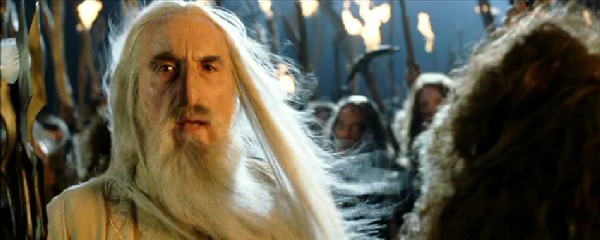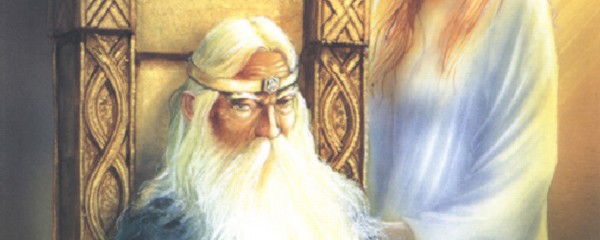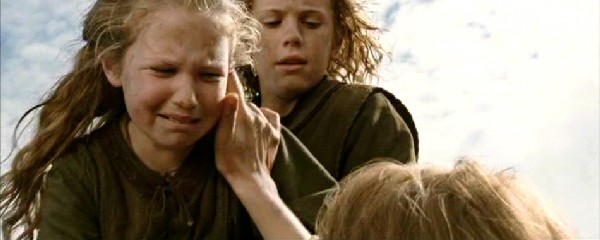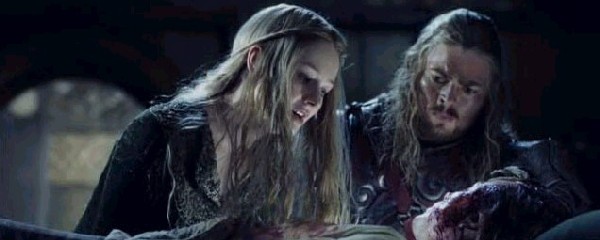3.01.*b. The Burning of the Westfold by Figwit

How does it happen in the movie?
Saruman, the evil wizard with the pointy fingernails, has forged a union with Sauron – who is still, all efforts aside, trying to gain complete dominion over the world. Our white-robed friend had decided that the best way to obtain this is through the utter destruction of Men. He starts out with Rohan, where he already has a hold over the old King, Théoden, through his counsellor Gríma Wormtongue – a ghastly creature who’s entire appearance screams ‘Evil-with-a-Capital-E’.
Saruman gathers some malcontent inhabitants of Dunland, the so-called Wild Men, who were driven from their lands by the Rohirrim and sends them off ‘to take revenge’. During the attack, Théoden’s son Théodred is injured badly and carried back to Edoras, the capital of Rohan, by Éomer – the King’s nephew.
As if all this doesn’t sound like a bad soap already, the King’s niece, Éowyn, is thrown into the mix. She is apparently one of the things promised to Gríma by the extremely malicious Saruman, should he be able to bring Rohan down. Éomer, clearly the brightest kid on the hill, has figured all of this out on his own (and by finding dead Uruks wearing the hand of Saruman by the Ford) and gets banished from Rohan by Gríma.

How did it happen in the books?
Very simple: not. The entire sequence is constructed from background information handed to the readers of ‘The Two Towers’ in chapter 3.VI. The King of the Golden Hall, and randomly scattered about the books.
The Battle of the Isen
‘It is not yet five days since the bitter tidings came that Théodred your son was slain upon the West Marches: your right-hand, Second Marshal of the Mark.’
The sentence quoted above is spoken by Gríma Wormtongue during the confrontation with Gandalf and the three hunters. While in the movie Théoden is only barely conscious, and doesn’t realise Théodred has died until he is already well awake again; in the books Théoden is aware of what has happened. Théodred also died at the spot, and was not carried back by Éomer and his men. It was in fact Erkenbrand who took charge of the remaining Rohirrim, and it is his company that comes to the rescue at the Battle of Helm’s Deep. We know this from Ceorl, one of the survivors of the battle that the King and his company meet on their route to Helm’s Deep: Erkenbrand of Westfold has drawn off those men he could gather towards his fastness in Helm’s Deep. The rest are scattered. [3.VII.]
That Saruman got the aid of the Wild Men is only mentioned during the same encounter, when Ceorl informs the Riders of their perilous position: Things have gone evilly since Théodred fell. We were driven back yesterday over the Isen with great loss; many perished at the crossing. Then at night fresh forces came over the river against our camp. All Isengard must be emptied; and Saruman has armed the wild hillmen and herd-folk of Dunland beyond the rivers, and these also he loosed upon us. [3.VII.]
The movie gives us very little background for these Wild Men. There is a little bit of information in the interaction between Saruman and his ‘army’ of Men:
Saruman: The Horsemen took your lands. They drove your people into the hills to scratch a living off rocks!
Wild Man: Murderers!
Saruman: Take back the lands they stole from you, burn every village.
In the book, Gamling tells Éomer that ‘they hate us, and they are glad; for our doom seems certain to them. “The king, the king!” they cry. “We will take their king. Death to the Forgoil! Death to the Strawheads! Death to the robbers of the North!” … Not in half a thousand years have they forgotten their grievance that the lords of Gondor gave the Mark to Eorl the Young and made alliance with him. That old hatred Saruman has inflamed.’ [3.VII.] This political fact, the Oath of Eorl, dates back hundres of years; something which is not clear from the movie.
The Subplot with the Kids on the Horse
One of the more puzzling additions to the script is the story of Freda and Éothain, two Rohirrim children who are placed on the back of a horse by their mother Morwen and carried to safety, in this case Edoras. Their only point seems to be pointing out to Théoden that his people are under attack, something which he also could have guessed from his sons death and the undoubtedly many reports that should cross his desk as a King.
(For more on the names of these characters, look under Bookie Details.)
A Happy Family Reunion
Éomer never had to carry a slightly blue-ish looking Théodred back to Meduseld, and Éowyn was never described as ‘weeping for him’.
The scene with Éomer cornering and attacking Wormtongue, is derived from a couple of lines Gandalf speaks in 3.VI. The King of the Golden Hall: ‘How long is it since Saruman bought you? What was the promised price? When all the men were dead, you were to pick your share of the treasure, and take the woman you desire? Too long have you watched her under your eyelids and haunted her steps.’
Éomer grasped his sword. ‘That I knew already,’ he muttered. ‘For that reason I would have slain him before, forgetting the law of the hall. But there are other reasons.’
It is clear from this that Éomer already suspected a lot of what was going on, like he did in the movie. The scene here is probably a reconstruction of the incident Éomer refers to.
Éomer’s banishment is based on this line from Théoden in the same chapter: ‘[Éomer] had rebelled against my commands, and threatened death to Gríma in my hall.’ He gives it as an explanation for the fact that Éomer is held prisoner in Meduseld. Éomer, after encountering the three hunters, had returned to Edoras only to be placed behind bars. It is Háma, Théoden’s doorwarden, who sets him free after his King is ‘healed’ by Gandalf.
In the movie, this story was sort of twisted around, resulting in Éomer’s banishment for the very same reasons, but before his encounter with Aragorn. This way, he replaced Erkenbrand as leader of the éored that saves the day at Helm’s Deep.
To Sharkey or Not to Sharkey
The movie gives a more prominent role to Saruman the White, as an actor in all these events. In the books we only get information about him through other characters – there are only four chapters where he actually comes into the picture as a character (2.II. The Council of Elrond; 3.X. The Voice of Saruman; 6.VI. Many Partings; 6.VIII. The Scouring of the Shire).
As a result, most of the scenes with Saruman, especially in ‘The Two Towers’, are completely made up by the screenwriters. The ultimate proof that bookies don’t necessarily hate every change made to their favourite trilogy is that no one ever complains about these added Saruman-scenes: they flesh out the character.
The addition of more Saruman to ‘The Two Towers’, and specifically in the ‘The Burning of the Westfold’-sequence, has a double function: to make the enemy more visible and his actions more clear, and to clarify some of the intricacies of Tolkien’s political world. Saruman ripping out the trees in the EE, for instance, sets up the anger of Treebeard when he leaves Fangorn. His ‘pact’ with the Wild Men introduces his desire to wipe out Rohan, and his capacity to delude people – he clearly states that the world of Men is ending, he is actually going to commit genocide, which also means getting rid of his associates the Dunlendings. Finally, this scene also shows Saruman as a leader, a captain general -–building up to the scene where he speaks to his troops from the balcony, much like Hitler in Leni Riefenstahl’s ‘Triumph of the Will’ (on which that scene is based).

Mistakes
– Peter Jackson and his team tampered with the ages of the Rohirrim: Théodred was forty when he died, while the young actor who plays him looks barely over twenty. Éowyn on the other hand is a fair 23 years old (Miranda Otto was well in her thirties during filming), and Théoden is already seventy years old when the War of the Ring starts.
Borrowed Lines
– Gandalf’s ‘How long is it since Saruman bought you? What was the promised price? When all the men were dead, you were to pick your share of the treasure, and take the woman you desire? Too long have you watched her under your eyelids and haunted her steps’ [3.VI.], addressing Wormtongue, was given to Éomer and changed to: ”How long is it since Saruman bought you? What was the promised price? When all the men were dead, you were to pick your share of the treasure? Too long have you watched her. Too long have you haunted her steps.’
Bookie Details
– The Wild Men are a nice touch, especially since they’re hardly mentioned. They represent Tolkien’s awareness of the possibility of evil in Men, but also help to portray Saruman as a manipulator.
– On an interesting side-note: Éothain was the name of one of Éomer’s men during the Battle of the Pelennor Fields. There are two Morwen’s in Tolkien’s writings: the wife of Húrin and mother of Túrin Turambar, and a Gondorian lady who became wife to King Thengel of Rohan – mother of King Théoden. I couldn’t find a Freda, however it’s a name (akin to Frida or Friedl) very common amongst Northern Europeans.

- Éomer by elenluin
- Éowyn by Aervir
- GrÃma by atalante_star
- Théoden atalante_star
- Théodred by atalante_star
Interesting Links:
Our Gallery has has screencaps of the theatrical version, as well as the extended edition.
A transcript of 'The Lord Of the Rings: The Two Towers' can be found in our Film Fun & Facts section.
A summary of 'The Lord Of the Rings: The Two Towers' can be found in Elrond's Library.
Some articles that are related to this sequence:
- Some more information about the Rohirrim can be found in our Middle-earth section, which has articles about The History of the Rohirrim, Éowyn of Rohan, Théoden son of Thengel, GrÃma Wormtongue and a Family Tree of The Kings of the Mark.
The Middle-earth section also has an article about Saruman, and another one about his Relation to the One Ring.
- In the Literature Articles section you can find an article about Saruman and Technology, and about The Rohirrim and the Anglo-Saxons.
Forum threads related to this sequence:
- You can discuss this sequence in detail in TTT Sequence by Sequence #3: Three Hunters / Saruman / Edoras and TTT EE Sequence by Sequence #3: The Burning of the Westfold in the Movies Forum.
- The Casting Forum wonders if ...anyone else likes Théodred?.
Take a look at how some artists saw this part in the book:
- Edoras by John Howe
- Théoden and Éowyn by Montanini
Looking for something more creative - you may find it here:









